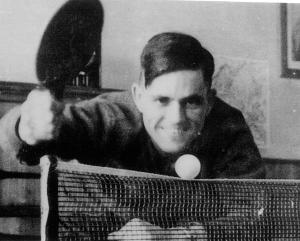1.3: C.3- Gerhard Gentzen
- Page ID
- 121765
\( \newcommand{\vecs}[1]{\overset { \scriptstyle \rightharpoonup} {\mathbf{#1}} } \)
\( \newcommand{\vecd}[1]{\overset{-\!-\!\rightharpoonup}{\vphantom{a}\smash {#1}}} \)
\( \newcommand{\id}{\mathrm{id}}\) \( \newcommand{\Span}{\mathrm{span}}\)
( \newcommand{\kernel}{\mathrm{null}\,}\) \( \newcommand{\range}{\mathrm{range}\,}\)
\( \newcommand{\RealPart}{\mathrm{Re}}\) \( \newcommand{\ImaginaryPart}{\mathrm{Im}}\)
\( \newcommand{\Argument}{\mathrm{Arg}}\) \( \newcommand{\norm}[1]{\| #1 \|}\)
\( \newcommand{\inner}[2]{\langle #1, #2 \rangle}\)
\( \newcommand{\Span}{\mathrm{span}}\)
\( \newcommand{\id}{\mathrm{id}}\)
\( \newcommand{\Span}{\mathrm{span}}\)
\( \newcommand{\kernel}{\mathrm{null}\,}\)
\( \newcommand{\range}{\mathrm{range}\,}\)
\( \newcommand{\RealPart}{\mathrm{Re}}\)
\( \newcommand{\ImaginaryPart}{\mathrm{Im}}\)
\( \newcommand{\Argument}{\mathrm{Arg}}\)
\( \newcommand{\norm}[1]{\| #1 \|}\)
\( \newcommand{\inner}[2]{\langle #1, #2 \rangle}\)
\( \newcommand{\Span}{\mathrm{span}}\) \( \newcommand{\AA}{\unicode[.8,0]{x212B}}\)
\( \newcommand{\vectorA}[1]{\vec{#1}} % arrow\)
\( \newcommand{\vectorAt}[1]{\vec{\text{#1}}} % arrow\)
\( \newcommand{\vectorB}[1]{\overset { \scriptstyle \rightharpoonup} {\mathbf{#1}} } \)
\( \newcommand{\vectorC}[1]{\textbf{#1}} \)
\( \newcommand{\vectorD}[1]{\overrightarrow{#1}} \)
\( \newcommand{\vectorDt}[1]{\overrightarrow{\text{#1}}} \)
\( \newcommand{\vectE}[1]{\overset{-\!-\!\rightharpoonup}{\vphantom{a}\smash{\mathbf {#1}}}} \)
\( \newcommand{\vecs}[1]{\overset { \scriptstyle \rightharpoonup} {\mathbf{#1}} } \)
\( \newcommand{\vecd}[1]{\overset{-\!-\!\rightharpoonup}{\vphantom{a}\smash {#1}}} \)
Gerhard Gentzen is known primarily as the creator of structural proof theory, and specifically the creation of the natural deduction and sequent calculus proof systems. He was born on November 24, 1909 in Greifswald, Germany. Gerhard was homeschooled for three years before attending preparatory school, where he was behind most of his classmates in terms of education. Despite this, he was a brilliant student and showed a strong aptitude for mathematics. His interests were varied, and he, for instance, also wrote poems for his mother and plays for the school theatre.
Gentzen began his university studies at the University of Greifswald, but moved around to Göttingen, Munich, and Berlin. He received his doctorate in 1933 from the University of Göttingen under Hermann Weyl. (Paul Bernays supervised most of his work, but was dismissed from the university by the Nazis.) In 1934, Gentzen began work as an assistant to David Hilbert. That same year he developed the sequent calculus and natural deduction proof systems, in his papers Untersuchungen über das logische Schließen I–II [Investigations Into Logical Deduction I–II]. He proved the consistency of the Peano axioms in 1936.
Gentzen’s relationship with the Nazis is complicated. At the same time his mentor Bernays was forced to leave Germany, Gentzen joined the university branch of the SA, the Nazi paramilitary organization. Like many Germans, he was a member of the Nazi party. During the war, he served as a telecommunications officer for the air intelligence unit. However, in 1942 he was released from duty due to a nervous breakdown. It is unclear whether or not Gentzen’s loyalties lay with the Nazi party, or whether he joined the party in order to ensure academic success.
In 1943, Gentzen was offered an academic position at the Mathematical Institute of the German University of Prague, which he accepted. However, in 1945 the citizens of Prague revolted against German occupation. Soviet forces arrived in the city and arrested all the professors at the university. Because of his membership in Nazi organizations, Gentzen was taken to a forced labour camp. He died of malnutrition while in his cell on August 4, 1945 at the age of 35.

Further Reading
For a full biography of Gentzen, see Menzler-Trott (2007). An interesting read about mathematicians under Nazi rule, which gives a brief note about Gentzen’s life, is given by Segal (2014). Gentzen’s papers on logical deduction are available in the original German (Gentzen, 1935a,b). English translations of Gentzen’s papers have been collected in a single volume by Szabo (1969), which also includes a biographical sketch.


